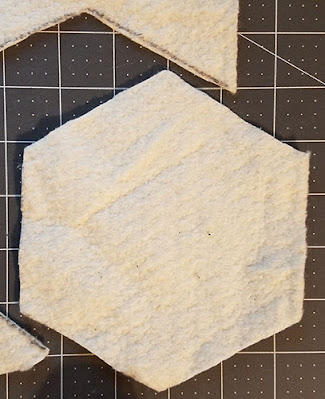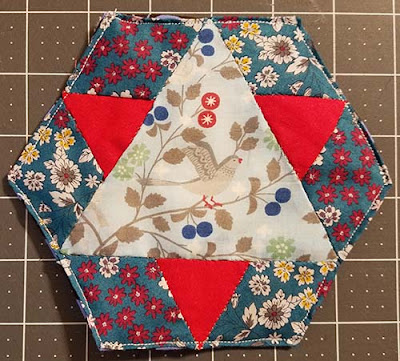Are you a wannabe traveler, sitting at home, while your muscles and your miles (frequent flier) stagnate?
Put another way, this tutorial shows how I used fabric from Paris, and one of the blocks in my new English Paper Piecing book, "Hexagon Star Quilts," to make a coaster. It would also work as a hanging ornament. You can adapt this technique to finish any EPP block.
By the way, English Paper Piecing really does come from England, and has always been very popular there. Right now, it's enjoying a huge resurgence around the world, for good reason - it's portable, easy, relaxing and addictive.
This particular project started with a pile of fat quarters I was lucky enough to buy in France two years ago (my fabric-related adventures there are blogged here).
French Frou Frou, looks similar to Liberty of London; it's lightweight and often floral, but not as expensive. Frou Frou is easy to find in US shops, with a little help from the Internet. (William Morris fabrics have a similar look.)
INSTRUCTIONS
1. Choose three fabrics with varying values and hues.
2. If you own my book, photocopy or scan Star 83 onto cardstock. In the photo, the book is on the left, and the scanned cardstock version on the right.
If you don't own my book, use the pink Dropbox link above to download the pattern and print it onto cardstock.
3. Cut around the outline.
4. Don't cut it apart yet! First we'll create a full-size backing with turned edges. For the back, I suggest you use a fabric that won't show cappuccino, croissant, or french fry stains. Lay the entire hexagon on the wrong side of your backing fabric.5. Cut around the edges, leaving at least 3/8" seam allowance.
Here's the reverse side with all edges pressed in.
6. Remove the cardstock and press the edges inward one more time, to get the folds sharp.
7. Don't cut up the pattern yet! We need it for one more thing - to cut the batting to size. Place it on a batting scrap.
8. Trace around it.
9. Cut just inside the line you drew.Now it's all cut out, leaving the drawn line behind.
10. Cut apart the cardstock pattern, and baste fabric to all its pieces, using your favorite English Paper Piecing techniques. If you are a beginner, my book has extensive explanation of different ways to baste, with thread or glue.
14. Remove all papers (right) from the back of the pieced block. (You may be able to reuse them to make more coasters!)
15. Place the top over the batting and backing.
16. Use pins or sewing clips to align the outer folds on top and bottom, and tuck seam allowances and tails inside the sandwich.
(Some of my clips are plastic - some are metal binder clips. I find the silver binder clips easier to open than black binder clips; the plastic ones are easiest of all on the hands.)
This is also an opportunity to baste one long edge of trim - like rick-rack - between the layers, extending beyond the edge.
Back:
Now heat up the espresso machine (or locate your can of instant cappuccino powder), and you're ready for your Zoom cafe, perhaps with a virtual background of the Eiffel Tower. It's not the same as being there - but look on the bright side - you don't have to inhale other peoples' cigarette smoke!?































No comments:
Post a Comment
Thank you for commenting!